Most Beautiful Butterflies: Top 10 Candidates
The Blue Morpho butterfly, celebrated for its brilliant iridescent blue wings created by microscopic scales that reflect light, is often considered one of the most beautiful butterflies in existence. Native to Central and South American tropical rainforests, its structural coloration serves to attract mates and evade predators.
The butterfly's ventral side is brown with eye spots, enhancing camouflage. With a wingspan reaching up to 15 cm, the Blue Morpho is notable in entomological studies.
Its visual splendor and adaptive strategies make it a fascinating subject for further exploration into the diversity and wonder of butterfly species.
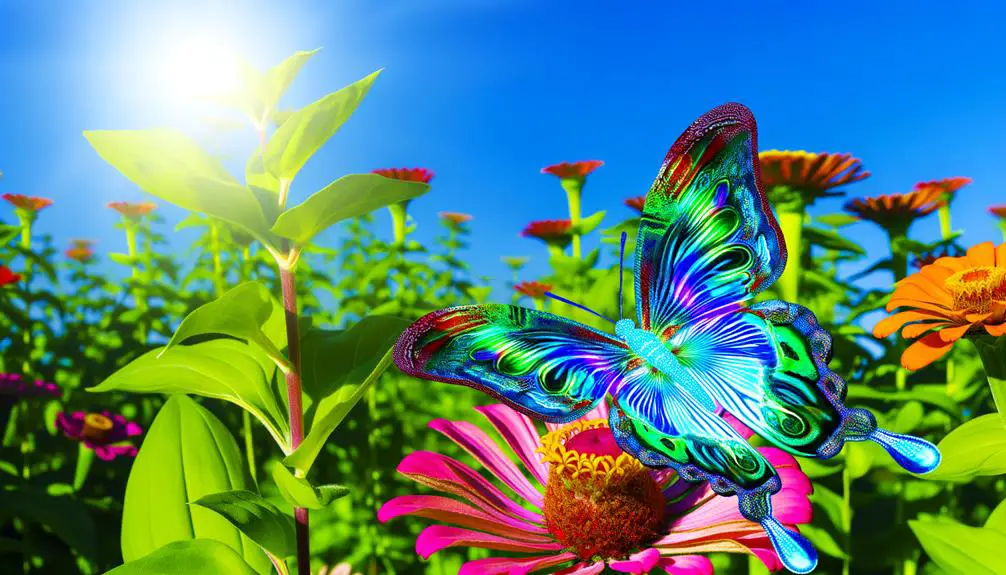
Key Takeaways
- The Blue Morpho's iridescent blue wings make it a standout for beauty.
- Monarch Butterflies are admired for their striking orange and black patterns and epic migrations.
- Swallowtail varieties, especially the Eastern Tiger and Blue Swallowtail, are noted for their vibrant color patterns and elegant tail extensions.
- Glasswing Beauties are unique with their transparent wings that minimize light scattering, creating a nearly invisible effect.
Blue Morpho

The Blue Morpho (Morpho menelaus), renowned for its iridescent blue wings, is a prominent species within the Nymphalidae family, native to the tropical rainforests of Central and South America.
The striking blue coloration is a result of microscopic scales on the dorsal side of the wings, which reflect light, creating a vivid blue appearance through structural coloration rather than pigmentation (Vukusic et al., 1999). This visual phenomenon aids in mate attraction and predator avoidance.
The ventral side, in contrast, is brown with eye spots, providing camouflage against predators when the wings are closed.
With a wingspan reaching up to 15 cm, the Blue Morpho is not only visually stunning but also a significant subject of entomological studies focused on lepidopteran morphology and behavior.
Monarch Butterfly
Renowned for its remarkable migratory behavior, *Danaus plexippus*, commonly known as the Monarch Butterfly, exhibits a unique annual migration spanning thousands of kilometers from North America to central Mexico. This extraordinary journey is facilitated by a combination of environmental cues and physiological adaptations.
Monarchs are distinguished by their vivid orange and black wing patterns, which serve both as a warning to predators and a form of camouflage among autumnal foliage.
Key features of the Monarch Butterfly:
- Migratory Navigation: Utilizes a combination of solar compass and magnetic fields.
- Lifecycle: Undergoes complete metamorphosis through egg, larva, pupa, and adult stages.
- Diet: Larvae feed exclusively on milkweed, while adults consume nectar.
- Lifespan: Varies from two weeks to eight months, depending on generation.
Swallowtail Varieties
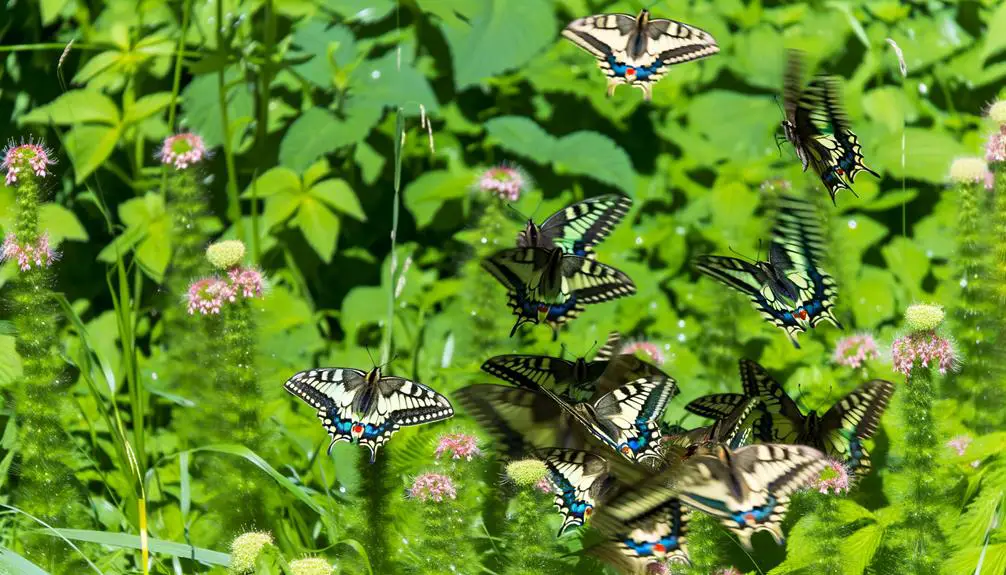
Beyond the remarkable Monarch Butterfly, the Swallowtail family (*Papilionidae*) encompasses a diverse array of species known for their strikingly colorful patterns and distinctive tail-like extensions on their hindwings.
Among these, the Eastern Tiger Swallowtail (*Papilio glaucus*) is notable for its yellow and black striped wings, while the Blue Swallowtail (*Papilio troilus*) showcases iridescent blue hues.
The Giant Swallowtail (*Papilio cresphontes*), North America's largest butterfly, exhibits contrasting yellow and black bands, creating a visually arresting appearance.
These butterflies are not only visually stunning but also play crucial roles in pollination.
Their larval stages often exhibit mimicry and cryptic coloration as evolutionary adaptations for survival against predators.
Glasswing Beauty
Glasswing butterflies (*Greta oto*), named for their transparent wings, exhibit a remarkable example of structural coloration that minimizes light scattering, making them nearly invisible to predators. This unique adaptation is achieved through the following characteristics:
- Nanostructures: The wings possess nanostructures that reduce reflection and refraction of light.
- Low-absorption pigmented scales: These scales contribute to the wing's transparency.
- Anti-reflective properties: The wings are coated with a substance that prevents glare.
- Flexibility: The wings are more flexible than those of other butterflies, aiding in evasion.
These features, supported by extensive entomological studies, highlight the intricate biological mechanisms that make *Greta oto* an extraordinary example of evolutionary adaptation.
Peacock Butterfly
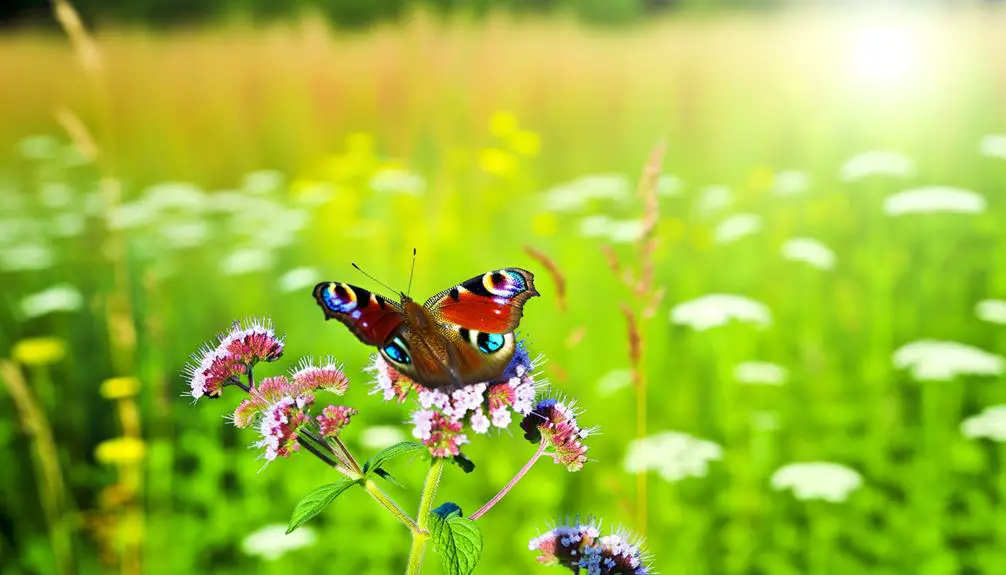
The Peacock Butterfly (*Aglais io*) is distinguished by its striking eyespots, which serve as a defense mechanism against predators. These eyespots mimic the appearance of larger animals' eyes, deterring potential threats. The vibrant coloration of the wings, featuring deep red backgrounds and iridescent blue spots, adds to its aesthetic appeal.
| Characteristic | Description | Function |
|---|---|---|
| Eyespots | Large, colorful spots on wings | Predator deterrence |
| Wing Coloration | Deep red with iridescent blue and yellow | Camouflage and mate attraction |
| Size | Wingspan of 50-55 mm | Moderate-sized butterfly |
| Habitat | Meadows, gardens, and woodlands | Diverse environments |
| Lifespan | Approximately 11 months | Relatively long-lived for species |
These butterflies thrive in diverse environments, from meadows to gardens, showcasing their adaptability (Pollard & Yates, 1993). Their presence is often encouraged by planting native flowers that provide nectar throughout the seasons. Experts recommend incorporating butterflyattracting garden colors, such as bright reds, purples, and yellows, to draw them in (Smith & Lee, 2005). By creating a suitable habitat with host plants for caterpillars, gardeners can support the entire butterfly life cycle.
Conclusion
In summation, the Blue Morpho, Monarch Butterfly, Swallowtail varieties, Glasswing Beauty, and Peacock Butterfly each exhibit remarkable aesthetic and ecological attributes, rendering them paragons of Lepidoptera magnificence.
These species, through their vivid coloration, intricate patterns, and diverse morphological adaptations, contribute notably to biodiversity and ecological balance.
It behooves entomologists and conservationists alike to continue research and preservation efforts to guarantee these butterflies remain extant, enriching both natural habitats and scientific understanding.
Such endeavors are essential for maintaining the delicate equilibrium of our ecosystem.


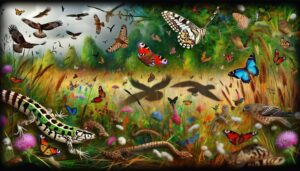
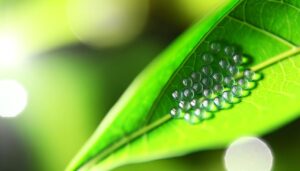
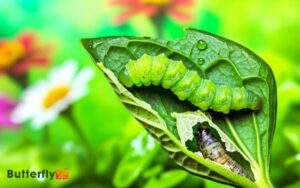

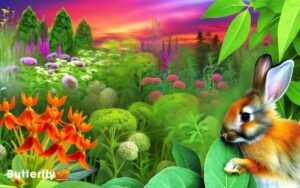
You can’t go incorrect with Dianabol or Anadrol for a blasting phase or
some other compounds mentioned above for slicing cycles. Nonetheless, that
may be more of a complicated technique that you’d need
a particular purpose to observe. Most users will be happy with the standard testosterone primary compound.
How a lot you achieve and keep after every cycle will come
down to private factors, however even a 5-10lbs maintainable
achieve from every cycle will accumulate through the years.
A lengthy steroid cycle will run anywhere from 3 months up to 9 months in length.
However, unwanted effects can include increased cancer
risk, liver toxicity, and diabetes. Skilled bodybuilders have used Human Development Hormone (HGH) for many
years to help them build muscle mass and improve energy.
The use of HGH is controversial, as it isn’t approved by the World Anti-Doping Agency (WADA).
Testosterone can enhance the anticoagulant action of warfarin.[18] Critical bleeding has been reported in some sufferers with this drug-drug interplay.
Though the mechanism is unclear, testosterone could cut back procoagulant factors.
Discount of warfarin dosage may be essential if testosterone remedy is coadministered.
Throughout workout muscles are damaged down, and HGH-X2 helps restore and develop muscle tissue.
Trenorol consistently ranks among the high three pre-workout supplements and has an approval ranking of 95%.
Increased power ranges mean you presumably can focus for a longer length and haven’t any mental fatigue.
Trenorol is a singular pre-workout complement designed
to achieve maximum outcomes. When you may be hitting the gym for weightlifting or
intense HIIT classes. It boosts endurance, and focus and enhances overall
exercise performance. Boosted protein synthesis, improved protein stage means you’ll be
able to repair and build muscle tissue simply at a quicker rate.
One research showed a bodybuilder who injected oil-based steroids intravenously suffered from
acute respiratory distress36. This situation was not an intended IV injection; as
a substitute, it mistakenly hit a vein when injecting it into the buttock muscle.
This exhibits us how careful we have to be when injecting,
ensuring no veins or arteries are impacted. For girls who are confident
sufficient with their previous steroid expertise
and feel ready to combine multiple steroid in a cycle, a
more advanced cycle could be undertaken.
However, it is necessary that every one the optimistic results
of eliminating fat aren’t overlapped by fluid retention. Subsequently,
for cutting cycles, choose steroids which most actively affect the breakdown of adipose tissue and haven’t any aromatization. The
greatest form of testosterone is dependent upon individual factors like your way of life, total health, and particular therapy objectives; options embody injections, gels,
patches, and oral tablets. It’s additionally essential to hunt medical
recommendation and ensure any testosterone remedy is
overseen by a healthcare provider to ensure safety and efficacy.
Testosterone replacement remedy (TRT) can present quite a few advantages for males with low testosterone
ranges. However, it is important to be cognizant of any potential side effects that may occur whereas present process TRT.
It’s also why those self same low doses can rapidly result in undesirable side effects developing44, lots of which are
going to be very completely different from the kinds of side effects that male steroid customers
fear about. When it involves bodybuilding and athletic performance, steroids have long been a controversial
but sought-after tool for attaining spectacular outcomes. Many athletes
and fitness fanatics turn to anabolic steroids to build muscle
mass, accelerate muscle development, improve restoration,
and improve general performance. However with so many choices in the marketplace, discovering respectable, high-quality
steroids for sale could be a daunting task. This information will assist you to navigate where to buy steroids on-line,
and which manufacturers you can trust for the best outcomes.
Due to its gentle nature, Oxandrolone is taken into account one of the most secure anabolic steroids available available on the market today.
It helps promote lean muscle progress, enhance strength,
and enhance endurance. Feminine customers might experience improved muscle definition and a toned
physique, making it an attractive option for these focused on aesthetics.
Moreover, Anavar can aid in fat loss by rising metabolic fee and
supporting the preservation of lean muscle mass throughout cutting
phases. It is price noting that while Anavar is mostly
well-tolerated by ladies, individual responses may vary.
Consulting with a healthcare skilled or experienced health
advisor is essential to discover out the appropriate dosage, cycle length, and
monitoring protocols primarily based on personal
targets and general well being. When it comes
to bulking, Anavar can be stacked with compounds
like testosterone or Deca Durabolin to promote vital muscle growth and strength features.
They shift the internal balance toward anabolism, leading to
a rise in muscle volume. At the moment, the modern market is overflowing with varied medicine, of
which Oral Steroids are more frequent among beginners and middle-level athletes.
There isn’t any shortage of choices throughout the fast-developing sports pharmacology market when finding the
best product in your needs.
It is important to start out with a lower dosage vary,
corresponding to 10mg per day, and gradually improve it to 20mg per day if well-tolerated.
Newbies should carefully monitor their body’s response to the
steroid and assess any potential unwanted effects.
By following a structured cycle, users purpose to maximise the benefits of Anavar while minimizing potential dangers
and unwanted effects. Understanding the key elements
and considerations of an Anavar cycle is essential for attaining desired
outcomes and maintaining total health and well-being.
The liquid steroids on the market in our catalog are available in the
form of both disposable ampoules or reusable vials all containing high-quality ingredients.
Additionally, most injectable compounds don’t need to be taken every day,
some whilst little as one time per week.
Stacking in these quick cycles is important since you’re
already getting the maximum of every compound. By combining them, you
profit from a better level of androgens with out necessarily increasing the
risk of unwanted aspect effects. Any of the above-recommended
stacks, for example, the Dianabol/Winstrol stack, will present satisfactory outcomes.
You can use the identical ancillary compounds because
the week cycle plans, though you won’t get some advantages that
want an extended cycle. Nevertheless, you can contemplate adding one thing like Clenbuterol and even T3 (Cytomel) or T4 if you’re an advanced and assured consumer who wants to ramp up fats burning.
As I’ve already detailed, blasting for dimension and strength
is almost identical to utilizing Anadrol or Dianabol as
a kickstart in longer cycles. What may change is your coaching and diet
to tweak the results based on personal objectives.
References:
JBHNews